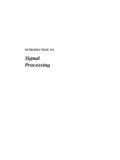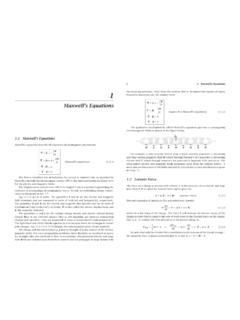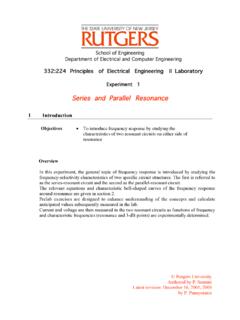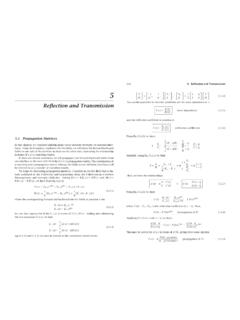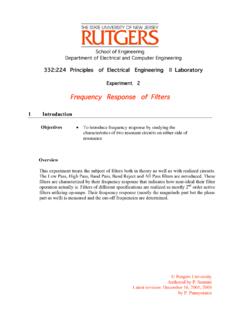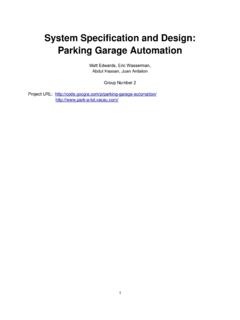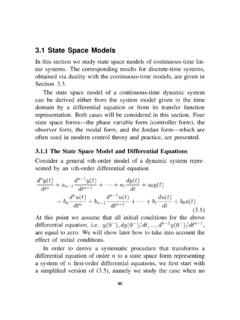Transcription of Chapter Six Transient and Steady State Responses
1 ChapterSixTransientandSteadyStateRespons esIncontrolsystemanalysisanddesignit isimportanttoconsiderthecompletesystemre sponseandtodesigncontrollerssuchthata satisfactoryresponseisobtainedforalltime instants , where :transientresponseandsteadystateresponse ,thatis ( )Thetransientresponseispresentintheshort periodoftimeimmediatelyafterthesystemis thesystemis asymptoticallystable,thetransientrespons edisappears,whichtheoreticallycanberecor dedas "!( )However,ifthesystemisunstable,thetransi entresponsewillincreaseveryquickly(expon entially)intime,andinthemostcasesthesyst emwillbepracticallyunusableorevendestroy edduringtheunstabletransientresponse(asc anoccur,forexample,insomeelectricalnetwo rks).
2 Evenifthesystemisasymptoticallystable,th etransientresponseshouldbecarefullymonit oredsincesomeundesiredphenomenalikehigh- frequencyoscillations( ),rapidchanges, asymptoticallystable, isimportantthatsteadystateresponsevalues areascloseaspossibletodesiredones(specif iedones)sothatwehavetostudythecorrespond ingerrors,whichrepresentthedifferencebet weentheactualanddesiredsystemoutputsatst eadystate, second-ordersystemduetoa , , , , ,ingeneral, ,where#representsthesystemstaticgainand$ is quiteeasytofindtheclosed-looptransferfun ctionofthissystem,thatis%'& (*),+.-&/(0)12&/(0)+34( 576984(:634( )Theclosed-looptransferfunctioncanbewrit teninthefollowingform-&/(0)12 G,H@I JGLKHCNMI( )U(s)+-s(Ts+1)KY(s) :Blockdiagramofa generalsecond-ordersystemQuantitiesPandQ SRarecalled,respectively,thesystemdampin gratioandthesystemnaturalfrequency.))
3 Thesystemeigenvaluesobtainedfrom( )aregivenbyTVUWX:Y[ZP QR2\^]QR`_aZPXY[ZP QR \b]Qdc( )whereQ,cis thesystemdampedfrequency. Thelocationofthesystempolesandtherelatio nbetweendampingratio, ++Re{s}Im{s} 2 1 n n d= n1 2 cos = :Second-ordersystemeigenvaluesin termsofparametersegfihkjlfmhkn264 TRANSIENTANDSTEADYSTATERESPONSESI nthefollowingwefindtheclosed-looprespons eofthissecond-ordersystemduetoa unitstepiso p qwehavertsq (b)theover-dampedcase,}> o; and(c)theunder-dampedcase,}> o. (a)theeigenvaluesaremultipleandreal,in(b )theyarerealanddistinct,andincase(c)thee igenvaluesarecomplexconjugate.(a)Critica llyDampedCaseFor}v~o, wegetfrom( )a doublepoleat wy.
4 Thecorrespondingoutputisobtainedfromr sq0u vwxyqsqzwyuxvoq oqzwy wysqzwyuxwhichaftertakingtheLaplaceinver seproduces s u v[o: l @ wy 0 g ( ) ,wherethelocationofthesystempoless V v xv xuisalsopresented.(b)Over-DampedCaseFort heover-dampedcase,wehavetworealandasympt oticallystablepolesat }wy wd . Thecorrespondingclosed-loopresponseis easilyobtainedfromr sq0u voqz qz>}wyzwd z xqz>}wy w, as s u v[oz 0 g l @ / z x ` g @ ( ) (c)(a)(b) 2 10 1 (a) p1=p2 4 20 1 (b) p1p2 202 2 1012(c) :Responsesofsecond-ordersystemsandlocati onsofsystempoles(c) pairofcomplexconjugatepolessothatinthe -domainwehave t @ , . g g | , ^ * d l > S * , ( )ApplyingtheLaplacetransformit iseasytoshow( )thatthesystemoutputinthetimedomainisgiv enby @ V g ^ ( ) g i ( ) (t) tpt stt :responseovershoot,settlingtime,peaktime , , asgivenby( ), 0 @ V g @ i , * V g @ d or S / , d g , TRANSIENTANDSTEADYSTATERESPONSES267which byusingrelations( ) 7 ( )It is leftasanexercisetostudentstoderive( )( ).]]
5 Fromthisequationwehave L S * ( )Thepeaktimeisobtainedfor 2 9 , d ( )andtimesforotherminimaandmaximaaregiven by l ( )Sincethesteadystatevalueof is ! " # $ , it followsthattheresponseovershootisgivenby %'& ( ) ! " # $ [ +*-,!.0/ 132 465+ > 7,!.0/ 1328495A ,.: ;<=6>:"?( )Overshootis veryoftenexpressedinpercent,sothatwecand efinethemaximumpercentovershootas@BA%C& %'& ED ,.: ;<=9>:? F @ D ( ) ,theexpressionfortheresponse5 percentsettlingtimecanbeobtainedas ( d +*,.0/ 124HG I [ J( )whichforthestandardvaluesof leadsto K L NM PO ( J 8 QSR L ( )Notethatinpractice TJIUV IUN , , ,designingsystemswithwidebandwidthis costly, :Considerthefollowingsecond-ordersystemX PY"Z [\]YEZ^[N_`Z!))]]]
6 Acb d Z b`Using( )and( )wegeteaf_`Cgef_dLhji kmlon pIdoqef_dgq_sr3tTuewv_efyxz {qa_}|~hji kml!nThepeaktimeisobtainedfrom( )as _ ev_ |~_zt d nandthesettlingtime,from( ),isfoundtobe E ~qef_ ~nThemaximumpercentovershootisequalto K C _ 6 " zr rYE [_z t ~ Thestepresponseofthissystemobtainedbythe MATLAB function[y,x]=step(num,den,t)witht=0 ,whichinthiscaseisapproximatelyequalto C r tT ( ).Also,MATLAB canbeusedtofindaccuratelythetransientres ponsesettlingtime( ). t [sec]y(t) , , thecaseinwhichanasymptoticallystablesyst emhasa pairofcomplexconjugatepoles(eigenvalues) (asa matteroffact,theydecayexponentiallywith ! , where arenegativerealpartsofthecorrespondingpo les).]
7 Thus,thesystemresponseisdominatedbythepa irofcomplexconjugatepolesclosesttotheima ginaryaxissincetheydecayslowest, , {s}Re {s}0 d ,forexample,a systemdescribedbyitstransferfunctionas B E ^ " ^ ] E ^ ! + E 3 $ E + $ " Sincethepolesat 60and 70arefartotheleft,theircontributiontothe systemresponseis negligible(theydecayveryquicklytozeroas ! $ and ^ ).Thetransferfunctioncanbeformallysimpli fiedasfollows E ^ " E 3 $ " $ w 3 + " 3 + 7 I " ^ ( ) :InthisexampleweuseMATLAB tocomparethestepresponsesoftheoriginalan dreduced-ordersystemswhosetransferfuncti onsaregivenin( ).
8 Theresultsobtainedfor " $ and (approximate) t [sec](1):y(t), (2):yr(t)(1)(2) :Systemstepresponsesfortheoriginal(1)and reduced-orderapproximate(2)systemsThecor respondingresponsesareobtainedbythefollo wingsequenceofMATLAB functionsz=-1;p=[-3 10 60 70];k=12600;[num,den]=zp2tf(z,p,k);t=0 :5;[y,x]=step(num,den,t);zr=-1;pr=[-3 10];kr=3;[numr,denr]=zp2tf(zr,pr,kr);[yr ,xr]=step(numr,denr,t);plot(t,y,t,yr, - );xlabel( timet [sec] );ylabel( (1):y(t),(2):yr(t) );grid;text( , , (1) );272 TRANSIENTANDSTEADYSTATERESPONSES text( , , (2) ); Similarlyonecanneglectthecomplexconjugat enon-dominantpoles, :Considerthefollowingtransferfunctioncon tainingtwopairsofcomplexconjugatepoles " " E m + ( + y y andthecorrespondingapproximatereduced-or dertransferfunctionobtainedby E ^ " " !)
9 C $ E + E + + E " c } E ^ t [sec](1):y(t), (2):yr(t)(1)(2) :Systemstepresponsesfortheoriginal(1)and approximate(2)systemswithcomplexconjugat epolesTRANSIENTANDSTEADYSTATERESPONSES27 3 Itcanbeseenfromthisfigurethata verygoodapproximationforthestepresponsei sobtainedbyusingtheapproximatereduced-or dermodel. However, , ,themethodofsingularperturbations(Kokoto vi c andKhalil,1986;Kokotovi cetal., 1986), (havinglargeandsmalltimeconstants,orslow andfastsystemmodes)areclusteredintwoorse veralgroups( ).Accordingtothetheoryofsingularperturba tions,ifit ispossibletofindanisolatedgroupofpoles(e igenvalues)closesttotheimaginaryaxis, {s}Re{s}0fast modesdominantslow.
10 Systemeigenvaluesclusteredintwodisjointg roupsThestatespaceformofsuchsystemsisgiv enby 3 L L L P P L C L ( $ ( )274 TRANSIENTANDSTEADYSTATERESPONSES where isa indicatesthatthetimederivativesforstatev ariables arelarge,sothatvariables changequickly,incontrasttovariables , areasymptoticallystable,thentheydecayver yquickly,sothatafterthefastdynamicsdisap pear 3 ,wegetanapproximationforthefastsubsystem as ' P L $ ( )Fromthisequationweareabletofind (assumingthatthematrix innonsingular,whichisthestandardassumpti oninthetheoryofsingularperturbations;Kok otovi cetal.))
